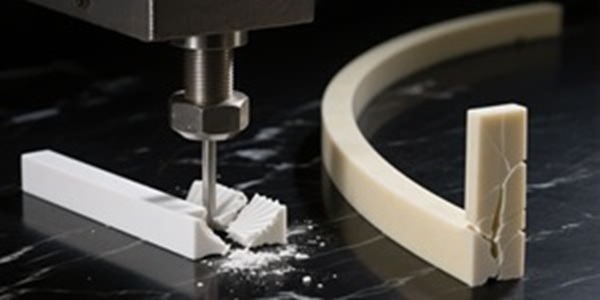Which is Stronger? Yield Strength of Alumina Compared to Zirconia
In the world of advanced ceramics, mechanical strength is a defining factor when selecting materials for industrial and engineering applications. Among the most widely used ceramic materials are alumina (Al₂O₃) and zirconia (ZrO₂), each with distinct properties. Yield strength, though traditionally associated with metals, is equally crucial in ceramics, particularly in understanding how materials behave under stress before failure. This article explores the yield strength and related mechanical properties of alumina and zirconia, helping engineers and buyers make informed decisions for high-performance components.
At Advanced Ceramic Hub, we specialize in high-quality alumina and zirconia products, ensuring optimal performance for industrial and scientific applications.

What Is Yield Strength and Why Is It Important in Ceramics?
Yield strength is the amount of stress a material can withstand before undergoing permanent deformation. In ceramics, which typically fail before plastically deforming, the term is used more loosely and is often expressed through substitute properties like flexural strength and compressive strength. These indicators help manufacturers and engineers evaluate how a ceramic will perform under mechanical load.
Key Terms Related to Yield Strength in Ceramics:
- Flexural Strength – Resistance to bending forces
- Compressive Strength – Stress capacity before crushing
- Fracture Toughness – Resistance to crack propagation
- Young’s Modulus – Stiffness of the ceramic
- Hardness – Surface resistance to indentation
Even though ceramics do not yield in the classical sense, understanding these substitute properties provides reliable insights into mechanical behavior.
How Strong Is Alumina in Terms of Yield Strength and Related Properties?
Alumina ceramics, especially high-purity grades (99.5%+), are known for their outstanding hardness, compressive strength, and electrical insulation capabilities. While they are inherently brittle under tensile stress, they offer impressive compressive resistance, making them useful in static and high-load environments such as crucibles and electronic substrates.
Mechanical Properties of Alumina Ceramics:
| Property | Value Range |
| Flexural Strength | 300–400 MPa |
| Compressive Strength | 2000–4000 MPa |
| Fracture Toughness | 3–4 MPa·m½ |
| Young’s Modulus | ~370 GPa |
| Hardness (Vickers) | ~15–20 GPa |
Although strong under compressive loads, alumina tends to be more brittle compared to zirconia, which limits its use in applications involving impact or vibration.
Explore our high-quality alumina products.
What Are the Strengths Advantages of Zirconia Compared to Alumina?
Zirconia ceramics outperform alumina in several mechanical categories thanks to their unique transformation toughening mechanism. This property allows zirconia to absorb stress and resist crack propagation, making it far more resilient under dynamic or flexural stress.
Mechanical Properties of Zirconia Ceramics:
| Property | Value Range |
| Flexural Strength | 800–1200 MPa |
| Compressive Strength | 2000–2500 MPa |
| Fracture Toughness | 6–10 MPa·m½ |
| Young’s Modulus | ~200 GPa |
| Hardness (Vickers) | ~12–14 GPa |
Zirconia’s ability to withstand repeated stress and shock loads makes it ideal for applications in medicine, aerospace, and mechanical systems.
Explore our high-quality zirconia products.
What Factors Affect the Yield Strength of Alumina and Zirconia?
The performance of ceramics like alumina and zirconia is heavily influenced by their manufacturing and microstructural characteristics. Grain size, density, additives, and sintering processes all play a significant role in determining mechanical behavior.
Factors That Influence Yield Strength:
- Grain Size: Finer grains typically improve mechanical strength.
- Density: Higher density leads to fewer voids and better performance.
- Additives: Stabilizers like Yttria improve zirconia’s toughness.
- Porosity: More pores result in reduced effective strength.
- Processing Technique: Methods like hot pressing yield better strength than conventional sintering.
Small adjustments in composition or processing can significantly alter a ceramic’s performance profile.
In Which Applications Does Alumina Outperform Zirconia?
Alumina is often the better choice where thermal resistance, hardness, and cost-effectiveness are priorities. It remains stable at high temperatures and performs well under compressive loads, making it ideal for furnace components and electronic insulators.
Applications Where Alumina Is Preferred:
- Electrical substrates and insulators
- Furnace linings and high-temperature crucibles
- Ball bearings and valve components
- Laser and electronic packaging
- Corrosion-resistant tubing
With a melting point of over 2000°C, alumina is a go-to material in thermally demanding environments.
When Should You Choose Zirconia Over Alumina for Strength?
Zirconia is preferred in situations that involve mechanical shock, dynamic loads, or high wear. Its superior fracture toughness and flexural strength enable long-term durability in precision and biomedical applications.
Applications Favoring Zirconia:
- Dental crowns and implants
- Cutting blades and industrial knives
- Hip replacement components
- Thermal barrier coatings
- Ball valves and fluid pumps
These use cases leverage zirconia’s unique mechanical resilience and reliability.
How Do Alumina and Zirconia Perform Under Compression and Flexural Stress?
Understanding stress-specific performance helps identify which ceramic is suitable for a given environment. Alumina excels under compressive loads but is weaker in flexure, whereas zirconia is more balanced and excels in bending and impact resistance.
Side-by-Side Mechanical Comparison:
| Property | Alumina (99.5%) | Zirconia (3Y-TZP) |
| Compressive Strength | 3000 MPa | 2200 MPa |
| Flexural Strength | 350 MPa | 1000 MPa |
| Fracture Toughness | 3.5 MPa·m½ | 8 MPa·m½ |
| Young’s Modulus | 370 GPa | 200 GPa |
While alumina is superior in compression, zirconia offers more versatility in environments where flexural stress is common.
Request a custom quote for alumina or zirconia products.
Are There Cost or Manufacturing Differences Between Alumina and Zirconia?
Cost and processing ease are critical considerations in material selection. Alumina is more abundant, simpler to produce, and significantly cheaper than zirconia, which requires advanced stabilization and tighter manufacturing controls.
Alumina vs. Zirconia Manufacturing Considerations:
- Cost: Alumina is ~30–50% cheaper
- Machinability: Alumina is more difficult to machine
- Sintering Temp: Both require >1500°C; zirconia stabilization adds complexity
- Availability: Alumina is globally standardized and easy to source
- Stabilization: Zirconia requires Yttria (Y₂O₃) or MgO additives
- These differences influence the total lifecycle cost of the component, particularly in mass production.
How Does the Yield Strength of Alumina and Zirconia Compare to Other Ceramic Materials?
Alumina and zirconia are leading structural ceramics, but other advanced ceramics like silicon carbide (SiC) and silicon nitride (Si₃N₄) offer different mechanical profiles. Comparing their flexural strength, fracture toughness, and stiffness helps engineers evaluate material choices under stress conditions similar to yield scenarios.
Yield-Related Mechanical Comparison of Ceramic Materials:
| Property | Alumina | Zirconia | Silicon Carbide | Silicon Nitride |
| Flexural Strength | 350 MPa | 1000 MPa | ~400 MPa | ~700 MPa |
| Fracture Toughness | 3.5 MPa·m½ | 8 MPa·m½ | ~3 MPa·m½ | ~7 MPa·m½ |
| Young’s Modulus | 370 GPa | 200 GPa | ~450 GPa | ~300 GPa |
| Density (g/cm³) | 3.9 | 6.0 | ~3.2 | ~3.2 |
| Thermal Conductivity | ~30 W/m·K | ~2 W/m·K | ~120 W/m·K | ~30 W/m·K |
Each ceramic brings unique strengths—alumina for high stiffness and thermal stability, zirconia for toughness and impact resistance, SiC for extreme thermal conductivity and wear, and Si₃N₄ for overall balance under mechanical load.
Request a custom quote for various ceramic products.
FAQ
| Question | Answer |
| Is zirconia always stronger than alumina? | In flexure and fracture, yes; not in compression. |
| Can alumina handle high loads? | Yes, especially in compression and thermal uses. |
| Which has better wear resistance? | Alumina is harder; better for abrasion. |
| Which is better for bending applications? | Zirconia due to transformation toughening. |
| Are both materials chemically stable? | Yes, but alumina resists acids better. |
Conclusion
Both alumina and zirconia offer exceptional mechanical characteristics, but their strengths lie in different domains. Alumina excels in compressive strength, thermal stability, and affordability, while zirconia shines in fracture toughness and flexural resistance. Understanding these nuances is vital for optimizing product design and longevity. The best choice often depends not just on yield strength, but also on cost, operating environment, and intended application. Consulting material data sheets and expert recommendations is always advisable before final selection.
Looking for high-quality alumina or zirconia ceramic products? Contact us today!
